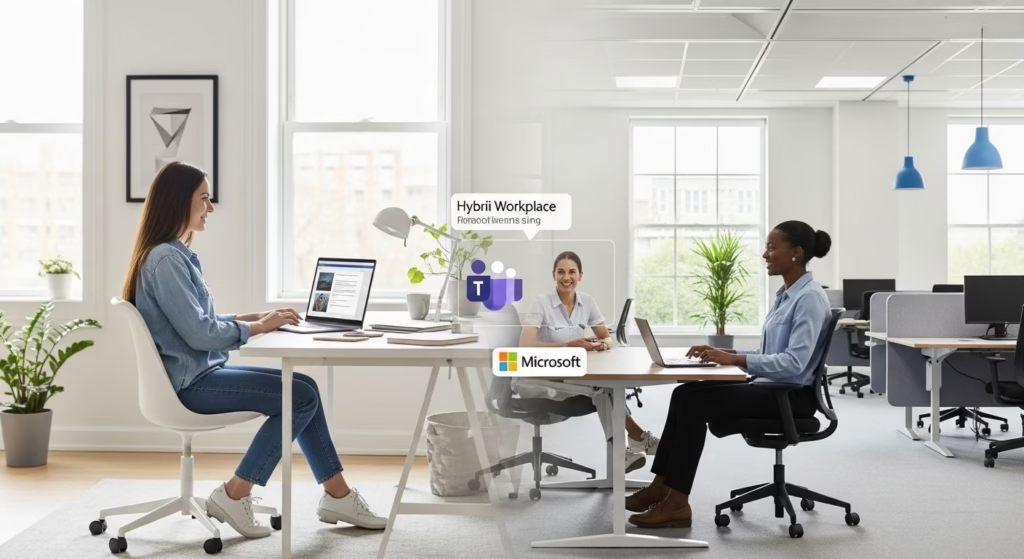Navigating the Hybrid Workplace: How Microsoft is Defining the Future of Work

The transition sparked by global events irrevocably changed where and how we work, pushing the concept of the 9-to-5 office model into history. At the forefront of defining this new era, the Hybrid Workplace, stands Microsoft. As a company that builds the very tools (Teams, Office, Azure) that enable distributed collaboration, Microsoft is not just observing the shift; it is setting the standard and actively researching the dynamics of the Future of Work.
For organizations and employees alike, understanding Microsoft’s strategy is critical. Their Flexible Work Policies, which often involve a mix of remote, home, and office-based work, are built on years of internal data and a philosophy centered on trust and intentional collaboration. This deep dive explores how Microsoft is navigating this complex landscape, balancing the need for Employee Well-being with the continuous drive for high Productivity. We will analyze their official policies, the critical role of technology (AI and specialized hardware), and the cultural shifts required to make hybrid work successful and sustainable.
The goal is not to find a single perfect solution, but to understand the trade-offs inherent in the Hybrid Workplace model and to equip leaders and team members with the insights needed to thrive in this decentralized Future of Work.
I. Microsoft’s Philosophy: Trust and Intentional Flexibility
Microsoft’s approach to the Hybrid Workplace is rooted in maximizing employee autonomy while ensuring clear expectations for collaboration and impact. Their policy framework is based on three core components:
1. The Employee-Centric Model
- Core Flexibility: Most Microsoft roles allow employees to work remotely up to 50% of the time without requiring specific management approval. This establishes a baseline of Flexible Work Policies built on trust.
- Manager Discretion: Managers are empowered to approve full-time remote work or specialized arrangements based on the job role, team function, and individual circumstances, moving away from a rigid, centralized mandate.
- Relocation Options: Microsoft offers significant geographical flexibility, though relocation may impact compensation based on the cost of labor in the new location. This acknowledges the economic realities of a distributed Hybrid Workplace.
2. The Need for Intentional Collaboration
While flexibility is provided, Microsoft emphasizes that the office space still serves critical functions—specifically, complex collaboration, team bonding, training, and building social capital. The focus shifts from required attendance to intentional in-person events.
- Defining Presence: Teams are encouraged to define why and when they need to gather, rather than simply enforcing days. This ensures time spent commuting delivers maximum value to both Productivity and culture.
- The “2-3 Rule”: Anecdotally, many internal teams settle into a rhythm of 2-3 in-office days per week for critical group tasks, striking a balance between autonomy and collective Productivity.

II. Technology as the Foundation of the Hybrid Workplace
Microsoft’s unique position as a major software provider means its Future of Work strategy is deeply intertwined with its product ecosystem. Their tools are being redesigned to ensure equity between remote and in-office participants.
A. Microsoft Teams and the Digital HQ
- Meeting Equity: Features like “Front Row” and intelligent cameras in Teams Rooms aim to ensure remote participants feel fully included. The emphasis is on making digital meetings the default for documentation and decision recording, even if some attendees are in the office.
- Asynchronous Communication: Recognizing that the time zone difference is magnified in the Hybrid Workplace, Microsoft heavily promotes tools like Microsoft Loop and asynchronous video (via Teams and Stream) to reduce reliance on immediate synchronous meetings, optimizing Productivity.
B. The Rise of AI and Copilot
The introduction of AI assistants like Copilot fundamentally alters the definition of Productivity within the Hybrid Workplace.
- Meeting Summarization: AI attends meetings, takes notes, and summarizes key decisions, ensuring employees who missed the meeting (due to flexible hours or time zones) can catch up quickly without demanding more synchronous time from colleagues.
- Efficiency Gains: By automating tedious drafting, searching, and summarizing tasks, Copilot frees up time for the complex, collaborative, and creative work that justifies in-person time in the Hybrid Workplace.
C. Hardware and Physical Space Redesign
Microsoft has invested heavily in redesigning both its physical offices and its hardware products (like Surface Hubs) to support the Hybrid Workplace seamlessly.
- Office as a Resource: The office is viewed less as a required destination and more as a high-quality resource for specific activities (e.g., soundproof focus booths, high-tech meeting rooms).
- Home Office Stipends: Providing financial support and guidance to employees setting up effective remote stations ensures that the remote aspect of Flexible Work Policies doesn’t compromise Productivity.
III. The Productivity Paradox: Measuring Work in the Hybrid Workplace
One of the largest challenges in the Hybrid Workplace is defining and measuring Productivity. Microsoft’s research (published in their annual Work Trend Index) highlights a significant paradox.
- The Illusion of Productivity: Data shows that many remote employees felt highly productive, but this often translated into busyness – more meetings, more emails, longer hours. This “digital debt” harms Employee Well-being.
- Collaboration Overload: The shift resulted in more synchronous collaboration time (meetings) and less focused, uninterrupted time for deep work. This strains technical teams particularly.
- The Role of Manager Anxiety: Microsoft studies show that a large percentage of managers struggle with “productivity paranoia,” fearing that remote employees aren’t working hard enough, leading to micromanagement which undermines Flexible Work Policies and trust.
Microsoft encourages moving away from activity metrics (emails sent, mouse clicks) toward outcome-based metrics (results delivered, projects completed) to truly assess Productivity in the Future of Work.
IV. Fostering Employee Well-being and Culture
A successful Hybrid Workplace must prioritize Employee Well-being to prevent burnout, which is a common byproduct of the always-on nature of distributed teams.
Addressing Digital Exhaustion
- “Decompression Days”: Microsoft encourages taking time off to mentally reset. They also implemented “no meeting Fridays” or mandated short breaks within long meetings to combat continuous digital engagement.
- MyAnalytics and Viva Insights: These internal tools give employees personalized data on their work patterns (e.g., focus time vs. meeting time, after-hours collaboration) to help them deliberately structure their day for better Employee Well-being.
- Boundary Setting: Training programs focus on teaching employees and managers how to set clear digital boundaries, respecting local time zones, and utilizing asynchronous communication methods to support Flexible Work Policies globally.
Maintaining Connection and Inclusion
In the Hybrid Workplace, maintaining strong internal culture requires conscious effort to ensure inclusion across distance.
- The Remote-First Mentality: Teams are encouraged to treat all meetings as if they have remote attendees, ensuring all documents are digital, cameras are on (even for in-office participants), and chat channels are utilized actively so information isn’t missed by those offsite.
- Social Capital Investment: Recognizing that spontaneous hallway conversations are lost, Microsoft encourages and funds intentional, non-work-related virtual and in-person social gatherings to strengthen team bonds and support Employee Well-being.
V. Strategies for Success in the Microsoft Hybrid Workplace
Based on Microsoft’s internal findings and external guidance, here are key strategies for employees and managers to successfully navigate the Hybrid Workplace and ensure high Productivity.
For Managers and Leaders:
- Coach for Flexibility: Managers must model the behavior of the Flexible Work Policies. This includes blocking out focus time on calendars and setting clear expectations about response times.
- Prioritize Outcomes over Activity: Shift performance reviews and daily check-ins to focus purely on business impact and results, reducing “productivity paranoia.”
- Invest in Team Cohesion: Budget time and resources for in-person gatherings that focus on building relationships and generating new ideas, reserving remote time for execution.
- Drive Meeting Discipline: Insist on agendas, clear roles, and designated note-takers for all meetings to protect employee time and increase meeting Productivity.
For Individual Contributors:
- Time Blocking: Use tools like Outlook and Viva Insights to proactively block focus time for deep work. Treat this blocked time as sacred to maximize Productivity.
- Be Intentional About Presence: If you go into the office, make sure your planned activities leverage in-person interaction (brainstorming, workshops). Avoid commuting just to sit on video calls.
- Define Digital Boundaries: Set clear limits for after-hours work. Communicate to your team when you are engaging in asynchronous work to manage expectations and protect Employee Well-being.
- Embrace New Technology: Actively learn and utilize tools like Copilot, Loop, and Teams features designed for hybrid equity. The Future of Work rewards digital fluency.
- Document Everything: Assume that not all colleagues were present at a meeting or saw a chat message. Over-documenting decisions and context ensures clarity across the distributed Hybrid Workplace.
Conclusion: Defining the Future of Work
Microsoft’s journey in defining the Hybrid Workplace reveals that this model is not merely a compromise between remote and office work; it is a fundamental shift in cultural expectations, technological reliance, and managerial philosophy. It recognizes that maximizing Productivity in the Future of Work requires empowering employees with Flexible Work Policies and investing in tools that bridge the digital and physical divide.
The lessons from Microsoft are clear: trust must replace surveillance, intentional collaboration must replace passive attendance, and Employee Well-being must be protected from digital exhaustion. As organizations continue to evolve, the ability to successfully navigate and optimize the complexities of the Hybrid Workplace will determine who leads the next generation of global Productivity and talent attraction.
- The 2026 HR Strategic Mandate: Governing Agentic Autonomy and Engineering the Human Workplace
- Why Walmart’s Store Managers Are Out-Earning MBA Grads (Without the Debt)
- New Tech, New Work: Redefining the Value Case for Technology Investment in the Modern Enterprise
- Top 10 McDonald’s Interview Questions (and How to Answer Them)
- No Degree Required: How IBM’s “New Collar” Jobs are Changing Tech Hiring
FAQ
What is the core principle of Microsoft’s Hybrid Workplace policy?
Microsoft’s policy is centered on trust and flexibility. Most employees are allowed to work remotely up to 50% of the time without specific manager approval. The emphasis is on outcomes and results rather than mandated office attendance, aligning with their goal of defining the Future of Work.
How does Microsoft measure employee Productivity in a hybrid model?
Microsoft encourages managers to shift away from measuring activity (like emails or hours spent online) toward measuring concrete outcomes and results. They use internal research to highlight the ‘Productivity Paradox,’ where being busy doesn’t always equal impact, and advocate for intentional focus time.
What role does AI, like Copilot, play in the Hybrid Workplace?
AI tools are critical enablers. Copilot helps manage the collaboration overload by automating tasks like meeting summarization, drafting communications, and synthesizing data. This frees up human time for high-value collaborative work, making the flexible work policies more sustainable and boosting overall productivity.
How does Microsoft address Employee Well-being and digital exhaustion?
Microsoft tackles this through initiatives like ‘Decompression Days,’ promoting ‘no meeting Fridays,’ and providing tools like Viva Insights. These resources offer personalized data on work patterns (e.g., after-hours collaboration) to help employees and managers set clear digital boundaries and protect focus time.
What are the key challenges Microsoft faces in its Hybrid Workplace model?
Primary challenges include managing the ‘Productivity Paradox’ (employees working longer hours but feeling disconnected), mitigating manager anxiety about remote work, ensuring meeting equity between physical and virtual participants, and maintaining team cohesion and culture across geographical distances.



